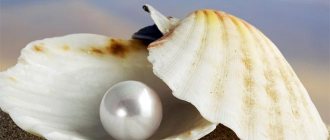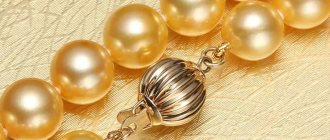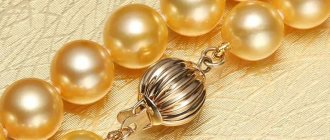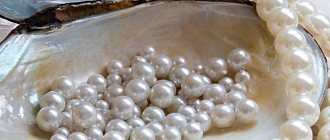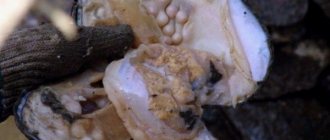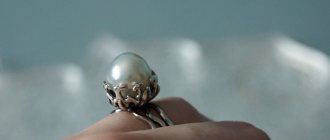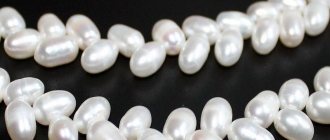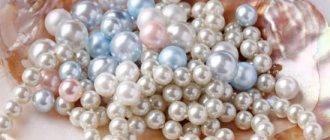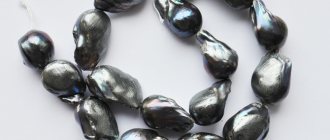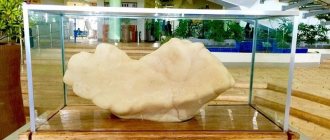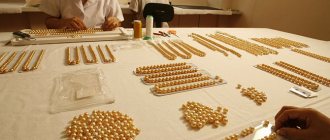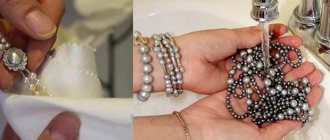HOW ARE PEARLS FORMED IN A SHELL
Wild pearls are produced in nature by some species of river and pearl species of marine mollusks. Only specimens covered with a layer of mother-of-pearl have commercial value. Not all mollusks have a shell with a pearl, but only:
- bivalve;
- some gastropods;
- one species of cephalopod;
- in freshwater representatives of the unionidae family (toothless, barley, folded comb).
Which shells contain pearls?
Bivalves are the main source and include:
- oysters;
- mussels;
- sea scallops.
Bivalves
Shells with shapeless pearls, called “baroque”, are mainly formed by river mollusks.
Pearls in shells in the form of a pear, oval, ball, blister (button) are found mainly in marine representatives.
The configuration depends on the location in the shell and is sometimes extremely bizarre, for example, “monsters” or “paragons” - formations in the form of animals or humans.
Why do oysters need pearls?
The origin of pearls is due to the presence of nacre on the inner walls of the shell. Since the mollusk feeds on filtered plankton, foreign bodies often get inside, for example, grains of sand. The oyster responds to the irritation by enveloping them in nacre, causing the mollusk to form a pearl.
How pearls grow
Foreign inclusions can be located between the mollusk's mantle and the shell valve or penetrate directly into the mantle - a fold of the body wall that is located between the visceral sac and the leg. We recommend: 50 shades of mother-of-pearl: how to distinguish sea pearls from river pearls
The growth of pearls
The fold forms a mantle cavity, communicating with the outside world and covered with epidermis. This layer produces nacre, covering the inside of the valves and any foreign bodies in concentric circles, isolating them.
- If a grain of sand adheres directly to the sash, the future pearl will be fused with it and nacre will not form in this place.
- If it penetrates into the mantle itself, a free round pearl will form. In the latter case, it is necessary that, along with the foreign body, epidermal cells also penetrate into the connective tissue of the mantle. They will begin to quickly divide, form a cyst (pearl sac) and begin to secrete nacre.
Interestingly, the mantle can form pearls without foreign inclusions; for this, it is enough to move the epidermis into the connective tissue: for example, as a result of mollusk pathology or mechanical damage from the outside.
Within 1-2 years, pearls grow in the shell, visible to the naked eye. Large natural pearls of precious categories mature over 10-12 years.
What is a pearl and what does it consist of?
The composition of pearls is close to the composition of shell nacre. In addition to the predominant calcium carbonate, it contains:
- conchiolin is an organic horn-like protein substance that forms the framework of the pearl and the outer layer of the shell;
- impurities of magnesium, manganese, titanium, strontium, zirconium, silver are characteristic of Crimean pearls.
Chemical composition of pearls
In this case, the layers of mineral (CaCO3) and conchiolin alternate and do not touch each other.
How many pearls can there be in one shell?
There can be up to several dozen pearls in a shell. So, in the shells of the Black Sea mussels there are over 100 pieces. The larger the number (over 100), the smaller their size (2.5-3 mm).
How pearls are born.
A shell yawned, by a wave, a speck of dust accidentally fell into its mouth, and a small pearl grew in it ... Such a shell garden. Uncle Galina Who doesn’t love pearls? In my opinion, they are the most delicate and exquisite stone. Indeed, jewelry with pearls will surely suit every woman! This article contains some of the facts about different types of pearls that I managed to collect in the public domain on the Internet. Enjoy reading and viewing!! I will be grateful for your comments, reviews and “likes”! A pearl is formed inside the shell of a mollusk as a result of a foreign object entering the shell. The mollusk perceives this as an invasion of its personal space, and begins to defend itself by producing nacre, which is deposited around the grain of sand. Thus, layer by layer, a pearl is formed and grows. There are three types of pearls: natural, cultured and artificial.
Natural pearls.
Natural natural pearls are formed in the wild without human intervention. Pearls grown in natural conditions are not sold in stores, you can only buy them at auctions or from private dealers, their price will be incredibly high. To find one good pearl, fishermen need to open hundreds of oysters.
At the same time, pearls of a regular round shape are the least likely to be found, which makes the extraction more expensive.
There are two types of wild pearls:
• marine (lighter and more durable, therefore more expensive);
• river (more often it is slightly elongated, fragile and cheaper).
Over time, when the method of growing cultured pearls appeared, the production of natural pearls decreased sharply. Products made from natural wild pearls cannot be passed on from generation to generation for a long time, because their average lifespan is only 60-80 years. Then the pearl begins to fade and crumble. Partly, it is precisely because of its rarity that jewelry with this type of pearl is so valued.
Cultured natural pearls.
Cultured natural pearls are the natural equivalent of wild gemstones. It should not be confused with imitations or, as they are also called, artificial pearls. It is formed as a result of the joint participation of a mollusk and a person. And, if the shape of natural pearls cannot be predicted, then the shape of a cultured pearl is determined by a person by placing a special ball inside the oyster, around which the pearl begins to form. Thus, up to 20 balls can be planted inside one mollusk for further cultivation of the pearl. The quality of a cultured pearl depends on the period of “ripening” - in 4 months a very thin layer of nacre is formed, and in 24 months the pearl will be covered with a durable layer. To check the quality of such pearls, they use X-rays or simply cut selected samples. All stores sell cultured pearls. The main suppliers of cultured pearls are China and Japan. Saltwater cultured pearls retain their shine and beauty much longer than freshwater ones, which is why the price is him much higher. Since any mold can be planted into a mollusk to become overgrown with mother-of-pearl, in China they often used molds of Buddha or animals, thereby obtaining pearl figurines. Artificial pearls.
Cultured pearls are entirely man-made, and the oyster is not involved in this process. Perhaps the most famous cultured pearls were created on the Spanish island of Mallorca over 120 years ago; and received the same name as the island. If we are dealing with high-quality imitation, then it is almost impossible to distinguish it from natural pearls with the naked eye. However, artificial pearls will not be able to play with light and shades of colors so brightly.
There are four types of artificial pearl production practiced:
1. Majorica (a ball of alabaster is covered with several dozen layers of mother-of-pearl).
2. Roman pearls (a glass ball filled with wax from the inside and covered with mother-of-pearl).
3. One-piece plastic ball onto which paint is applied.
4. A bead made of solid mother-of-pearl, which was given the desired shape.
Imitation pearls can also be quite expensive, especially if modern technologies are used to extend the life of the imitation. Therefore, this type of pearl is not necessarily a clumsy fake.
The largest pearls in the world. It was previously believed that the largest and most expensive pearl in the world was discovered by a pearl fisherman on the Philippine island of Palovan in 1934. Its diameter was 24 cm and its weight was 6.4 kg or 1280 carats. It was called by the owner “The Head of Allah”, since its irregular outline looks like a head in a turban.
A Filipino fisherman slept on a 34-kilogram pearl worth $100 million for ten years.
This giant pearl may be the largest ever found in the world - the pearl is 5 times heavier than the previous record holder, the Lao Tzu (Pearl of Allah).
The fisherman, who decided not to give his name, caught this treasure 10 years ago, in 2006, completely by accident. After a very strong storm off the coast of the island of Palawan, a Filipino tried to raise an anchor, which got caught on something. The fisherman dived into the water and pulled out a large clam, inside of which was a huge pearl.
Not realizing how valuable it was, the man kept the pearl for himself as a talisman. He simply kept the find, worth about $100 million, under his bed in a dilapidated house. Recently, there was a fire in a fisherman’s house, after which the man decided to show his talisman to an employee of the Philippine tourism department in the city of Puerto Princesa, so that the latter could help sell the “souvenir” for at least some money. The management was stunned by the man’s discovery—the value of the jewelry was estimated at $100 million.
How to distinguish types of pearls
As mentioned above, natural wild and cultured pearls look almost the same. There are several signs by which they can be distinguished.
1. Smooth does not mean real.
Wild pearls are formed by applying layers of nacre one after another. Since this process cannot be controlled, it is logical that the shape of natural pearls is always slightly imperfect. Try to carefully feel the pearl. If you do not feel any features of the texture, most likely this is an artificial analogue. Most often, with this method of determination, the pearl is rubbed against the surface of the tooth, since the enamel is very sensitive.
2. It's all about weight.
The pearls that people have made are very light. After all, these are either hollow glass beads or balls filled with wax. No matter how light a natural gemstone is, it is noticeably heavier than imitations.
3. Check for elasticity.
If you don't have a microscope handy or want to check the naturalness of the stone right now, a great way is to drop the pearl from a height of about half a meter onto a hard, smooth surface. Be careful if you have an imitation in front of you - it may be damaged. Nothing will happen to natural pearls. It is quite elastic, so it should quickly jump further after the impact. If the pearl jumps only once or twice, most likely this is a cultured version. If the stone rolls without jumping, it is a fake.
4. The inner world of a pearl.
If there are holes in the pearls, be sure to examine them. This will help you understand exactly what species it is. In the case of natural origin, inside you will see the same pearls that sparkle and shimmer. Do you see something matte inside that looks like plastic? This is an imitation. It is almost impossible to distinguish cultivated from wild in this way.
5. Natural means expensive.
Wild pearls are always expensive. Due to the rarity of suitable pearls and the difficulty of extraction, it simply cannot be cheap. Therefore, if you are offered only today and only now to buy natural pearls at a bargain price, you should not happily agree. Perhaps they want to sell you an imitation. Thank you for your attention!! I hope the article will be useful and interesting. Sincerely, Elena.
WHERE ARE PEARLS CULTIVATED?
Cultured pearls are obtained by growing on special plantations due to:
- introduction of an irritant that provokes the mollusk to secrete nacre;
- creating artificial conditions.
We recommend: Place of Power in Moscow - Ra stone
There are different methods for obtaining saltwater or freshwater cultured pearls.
Pearl farms
Huge garlands of shellfish are then suspended in a marine incubator on floats, where the precious material grows naturally. The shells are periodically turned over so that the mother of pearl is distributed evenly and the beads are perfectly spherical. Over the course of several years, real pearls appear in the oyster shell.
Pearl farms
Nuclear method
The formation of pearls can be with the use of a nucleus or without a nucleus. According to Japanese technology, introduced by the famous Mikimoto and patented in 1896, the shell flaps were slightly opened and small fragments of coral were introduced into it. Today, a mother-of-pearl ball made from the shell of a freshwater mollusk is used as a core.
Nuclear-free method
The birth of pearls can also be nuclear-free. In this case, pieces of the epithelium (epidermis) of another mollusk are introduced into the connective tissue of the mantle of one mollusk, as described above. The mortality rate of mollusks with a transplant ranges from 10 to 40%. If everything went well, the individual is placed in an incubator and waits for the jewel to appear.
Types of cultured pearls
In nature, pearls occur in several shades. Reddish, dark brown and violet-black material is found in the noble pinna. In addition, different mollusks form different pearls:
- abalone - oval white and blue-green with a strong shine;
- common chalk - round yellow-orange;
- buccinum vulgaris - pale colored;
- gastropods - shiny.
Haliotis
They cultivate mainly white, black, gold and akoya.
Akoya
This species is grown in the bivalve shells of mollusks of the genus Pinctada, the Japanese call them “akoya-kai” - hence the name. The characteristics of the material are as follows:
- size - 6-8 mm;
- cultivation - 1-4 years;
- color - pearlescent pink, pearlescent white, cream, rarely silver, silver-green.
The shape can be different, the ideal one is spherical.
Akoya
Gold
Golden pearls are formed in the pinctada maxima oyster, which lives in a small Pacific bay. The plantation for the cultivation of this material is located near the island. Palawan. It takes 5 years to mature.
We recommend: AKOYA PEARLS: description, authenticity, cultivation
Black
Pearls of this color are cultivated near the island. Tahiti, Cook, Marshall, Vietnam, Fiji, Micronesia, Australia in the shell of the mollusk Pinctada margaritifera. Drop-shaped shape up to 15 mm long.
Mollusk Pinctada margaritifera
White
The giant tridacna has shells that lack nacre and produces pink and milky white pearls. Therefore, these mollusks are used to grow it.
Pearl fishing in Russia: in the past and how it is grown today
Pearl mining in Russia was first mentioned in documentation dating back to the 10th-12th centuries. The heyday of the fishery falls on the 14th-16th centuries. During this period, people appreciated the beauty and value of pearls, streamlined and expanded the mining process, connecting more than 60 northern rivers to it. Unlike pearls in other countries of the world, including South Asian ones, which are obtained from the shells of marine mollusks, in Russia they practiced the sale of freshwater pearls.
On an unimaginable scale, mother-of-pearl wealth was mined in the Muna River on the Kola Peninsula. Basically, representatives of monasteries took part in the process. Pearls of that time were famous for their ideal spherical shape and almost flawless surface without growths or compactions. For this it was called “sloping”, that is, easily rolled down at an angle.
During the reign of Emperor Peter at the beginning of the 18th century, pearl fishing for private individuals was banned. Individual people received the right to extract mother-of-pearl pearls in accordance with charters issued by the sovereign. Already at this time, the country's resources were noticeably reduced. The fishery gradually came to a standstill. Roughly the same fate befell other countries of the world. Everything changed when the Japanese Mikimoto patented a technology for growing pearls in shells.
Today, 90% of the world's pearls are cultivated by humans. In Russia, fishing has been developed since the mid-20th century. Especially for this purpose, colonies of river mollusks were restored in rivers, where the current environmental situation allowed this to be done. Of course, the country's leadership among pearl exporters is in the distant past. The pearls mined today are still of rare colors: from silver to blue, but the volumes have nothing in common with the previous ones.
Freshwater pearls in the country ceased to be part of its material wealth. The rivers have become so impoverished that restoring populations requires a lot of time, effort, and expense. The reasons for the deplorable state of once-rich mollusk reservoirs are varied:
- hydraulic engineering;
- timber rafting;
- uncleanness;
- decrease in the population of fish carrying pearl mussel larvae.
Nevertheless, work to restore and increase the populations of pearl mussels is being carried out in the Onega and Solza rivers. If everything is done correctly and the destruction of newly bred mollusks is prevented, perhaps in a few decades the country will once again regain its position as a leader in the export of pearls on the world market.
There are several farms in Russia that grow freshwater pearls. The lifespan of a freshwater mollusk, unlike a sea mollusk, is only 13 years; after “grafting,” it produces active nacre for only 3 years. On average, 2-3 “harvests” can be obtained from the shell of one mollusk. Collected pearls rarely have a regular spherical shape, reach 12 mm in diameter, and have the following shades:
- white-pink;
- blue;
- brown;
- golden;
- orange.
Just like in sea farms, cultivation is practiced in shells placed in cages for protection on bamboo wood frames at a depth of several meters. On average, the yield of pearls in fresh water is 60%, which is much higher than in salt water. Most pearls are ideal for making beads. In this way, it is possible to hide small flaws, in the place of which holes are drilled for attaching the thread.
HOW ARTIFICIAL PEARL IS MADE
Cultured pearls are made without a shell and are not related to shellfish. These beads are distinguished by a rich palette of shades, rainbow tints and shine.
Majorca
The jewelry company Majorica produces the organic material by coating frosted glass with numerous layers of a substance obtained from the mother of pearl of the shell. Each layer is polished to achieve the perfect shape. It takes from 10 to 30 days to create one pearl.
Taraka
The formation mechanism of this product consists of two stages:
- First, a bead is made from mother-of-pearl removed from the inside of the shell.
- Then it is coated with polyamide and varnish.
Such pearls are quite durable, unlike natural ones, and have a beautiful shine.
France
This forming method is one of the oldest, used since the 16th century. Making French beads involves filling blown glass beads with wax (for weight).
